 |
 |
 |
| |
Evidence of international transmission of HCV in pan-European study of HIV-positive men who have sex with men (MSM)
|
| |
| |
Reported by Jules Levin
4th IAS Conference, 22-25 July, Sydney, Australia
"....This phylogenetic analysis reveals a large HCV transmission network among HIV-positive MSM in Europe.....presumably through increased travel associated with high-risk behaviours.....transmission related to behavioural change among MSM..."
"....in early 2000s it was recognized that there was an increased incidence of acute or recent HCV positivity in HIV+ population first described in London and there have now been almost 400 cases described in London and Brighton. Since then further cohorts have been described through Europe particularly in the Netherlands, Germany and France. Cohorts have now also been described in USA and Australia. This has been looked at by the Health Protection Authority in England and particularly looking at London & Brighton centers. They have reviewed the number of cases described at each of the HIV centers and since 2002 have described an increasing incidence of acute HCV within each of the clinics. The overall incidence has been over these years has been 9.1 cases per 1,000 patient years in HIV+ MSMs (Table 1). If you look at the individual clinics in London region up to 2% of the patient populations have become HCV+ over these few years (Picture 2). Transmission factors don't include IVDU but a high number of sexual partners, mucosally traumatic practices, involvement in group sex and high risk sexual practices, ulcerative sexually transmitted infections (STIs such as LGV, syphilis, gonorrhea), and recreational drug use and sharing (intranasal and intrarectal). So we set out to determine if there is evidence of a hepatitis C transmission network among European MSMs using a molecular phylogenetic analysis. Study population was HIV+ MSM diagnosed with recent HCV since 2000 comprised of 4 cohorts—UK, Netherlands, France, Germany—all previously described in cohorts. Definition of recent HCV described below. Median age of patients was 36-40 yrs. CD4s around 400-500+. Two-thirds on HAART. Phylogenetic analysis described below. Most sequences were genotype 1a (50%) followed by genotype 4 sequences. 90% of individual sequences are genotype 1a and 4, which are difficult to treat. The sequences are closely related: 88% are similar to 1 or more strains of other cases within the group, 73% are closely related. During Q&A Dante said that the same epidemic has been identified in Australia and they are collaborating but this has not apparently been recognized in the USA, in talking to people on the East Coast...."
M Danta1,9*, T van de Laar4*, D Brown1, O Pybus3, S Bhagani2, M Vogel5, S Neifer6, A Baumgarten6, H G_tz7, J Rockstroh5, S Bruisten4, G Dusheiko1, R Coutinho4,8
1UCL Institute of Hepatology, London, UK; 2Department of HIV Medicine, Royal Free and University College, London, UK; 3Department of Zoology, University of Oxford, UK; 4Cluster of Infectious Diseases, Health Service, Amsterdam, Netherlands; 5University of Bonn, Germany; 6Practice Dupke / Carganico / Baumgarten, Berlin, Germany; 7Department of Infectious Diseases, Health Service Rotterdam, Netherlands; 8Centre for Infectious Disease Control, National Institute of Public Health and the Environment, Bilthoven, Netherlands; 9St Vincent's Clinical School, UNSW, Australia.
AUTHOR CONCLUSIONS
Molecular analysis reveals large HCV transmission network among HIV-positive MSM in Europe.
Travel important factor in HCV transmission in this population.
The molecular HCV clusters, which cross subtype and genotype, suggests this epidemic is not due to a hepatitis C viral change, but rather behavioural and/or environmental factors.
Suggestion that increased country mixing with larger cluster size consistent with regional spread.
National public health agencies need targeted preventive strategies including screening of high-risk HIV-positive MSM to mitigate spread of HCV in this population.
ABSTRACT
Objective: Since 2000, there has been a reported rise in permucosal HCV transmission among European HIV-positive MSM related to high-risk sexual behaviours. We conducted a phylogenetic study to investigate the presence of a HCV transmission network among European MSM.
Methods: HIV-positive MSM diagnosed with acute HCV (n=178) in England, Netherlands and Germany between January 2000 and December 2006 were enrolled into a molecular phylogenetic study. Part of the NS5B region of the HCV genome (436 bp) was amplified using RT-PCR and subsequently sequenced and genotyped. NS5B phylogentic trees were constructed using MEGA 3.1 software, comparing MSM cases with unrelated NS5B sequences.
Results: NS5B sequences were obtained from 154/178 (87%) of cases; UK 86/107 (80%); Netherlands 46/47 (98%); Germany 22/24 (92%). Circulating HCV strains were of subtype 1a (60%), 4d (23%), 3a (8%), 1b (6%), 2b and 2c (3%). Phylogenetic analysis revealed 10 distinct HCV clusters (containing between 3-36 individuals; bootstrap values >70%) involving 129 (84%) of the sequences. Six of the ten clusters contained sequences from more than one country; 3 clusters contained sequences from all three countries. The majority (66%) of HCV sequences were in the five largest clusters, all of which contained sequences from different countries. There was a trend to country specific segregation occurring in smaller clusters compared with country non-specific clusters (4.5 median sequences/cluster versus 15.5 median sequences/cluster, p=0.07).
Conclusion: This phylogenetic analysis reveals a large HCV transmission network among HIV-positive MSM in Europe. International mixing increases with cluster size, emphasising the rapid spread of regional outbreaks to neighbouring countries, presumably through increased travel associated with high-risk behaviours. The emergence of co-circulating HCV lineages supports transmission related to behavioural change among MSM rather than intrinsic viral change. This has important implications for public health agencies mitigating HCV transmission.
Comparison of individual sequences
- 90% (149/166) of MSM have HCV genotypes 1 or 4
(Difficult treatment genotype SVR < 40%).
- 88% (147/166) of MSM have HCV strains similar to ≥ 1 MSM.
- 73% (122/166) of MSM have HCV closely related strains to ≥ 1 MSM of another European country.
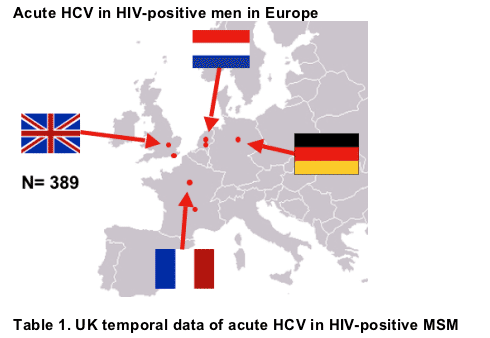
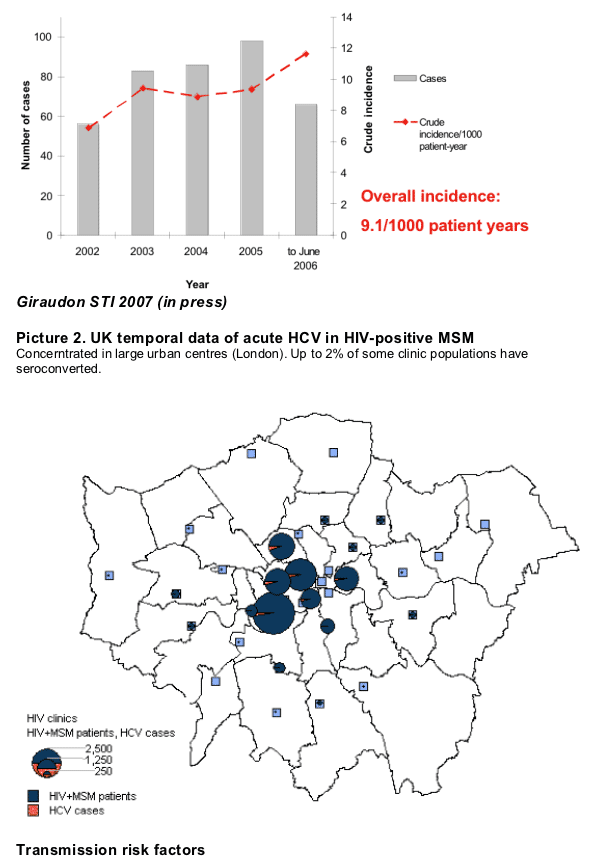
Permucosal NOT parenteral transmission.
Identified factors:
--High number of sexual partners.
--Mucosally traumatic sexual practices.
--Group sex practices.
--Ulcerative sexually transmitted infections (STIs).
--Recreational drug use and sharing (intranasal and intrarectal).
Danta AIDS 2007, Van de Laar JID 2007, Serpaggi AIDS 2006, Gotz AIDS 2005, Brown STI 2004
STUDY AIM
To determine if there is evidence of a HCV transmission network among European MSM using molecular phylogenetic analysis.
STUDY POPULATION
HIV-positive men who have sex with men (MSM) diagnosed with recent HCV since 2000.

Recent hepatitis C defined as:
--documented anti-HCV seroconversion within prior 12 months, or
--a positive HCV-RNA by polymerase chain reaction assay (PCR) following a negative assay within prior 12 months previously, or
--a positive HCV-RNA PCR and a serum alanine aminotransferase (ALT) level >10-times the upper limit of normal (ULN) with documented normal ALT during the preceding year.
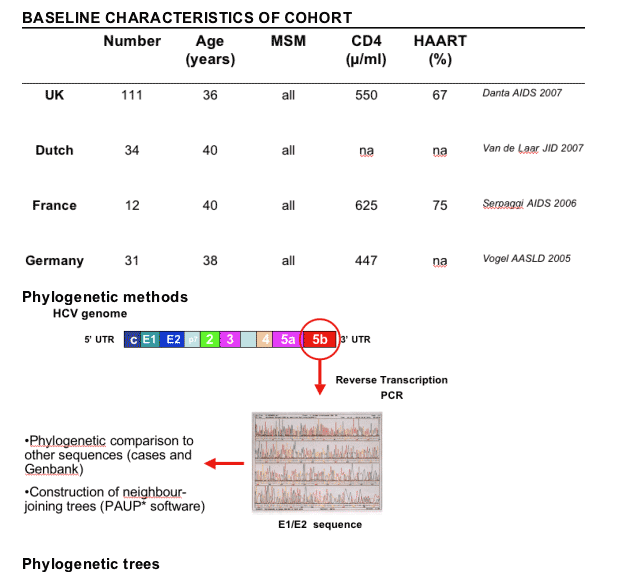
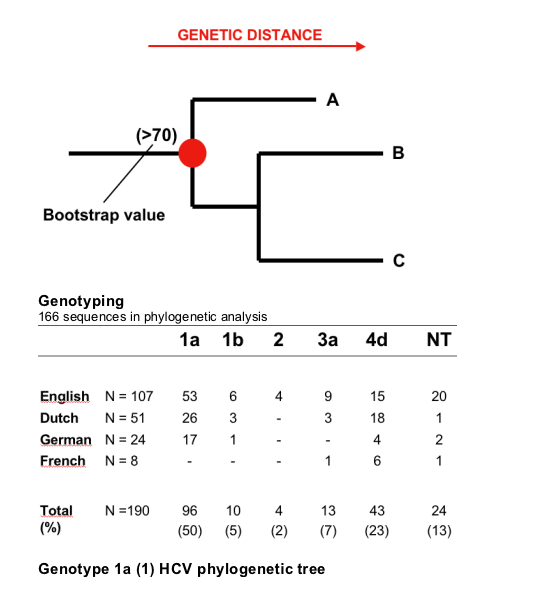
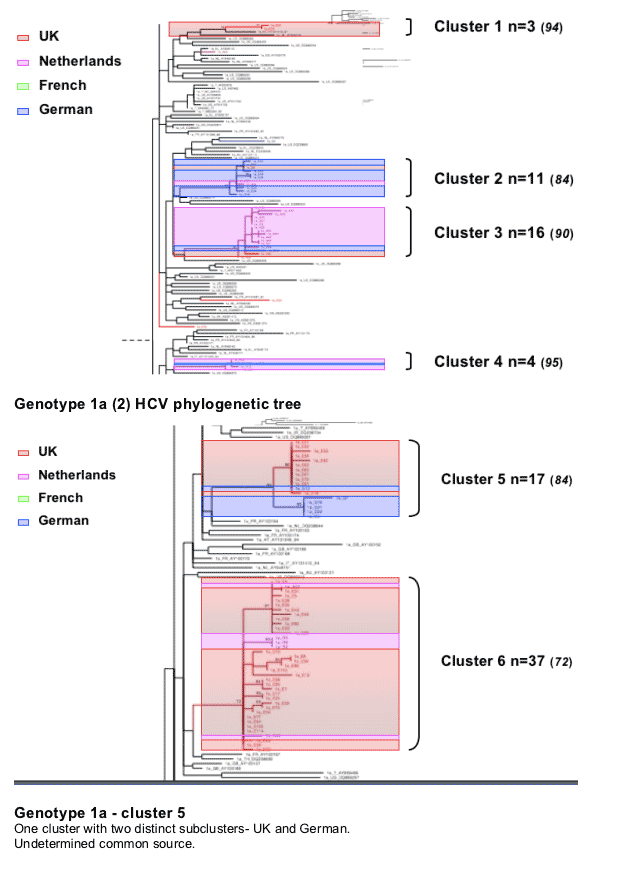
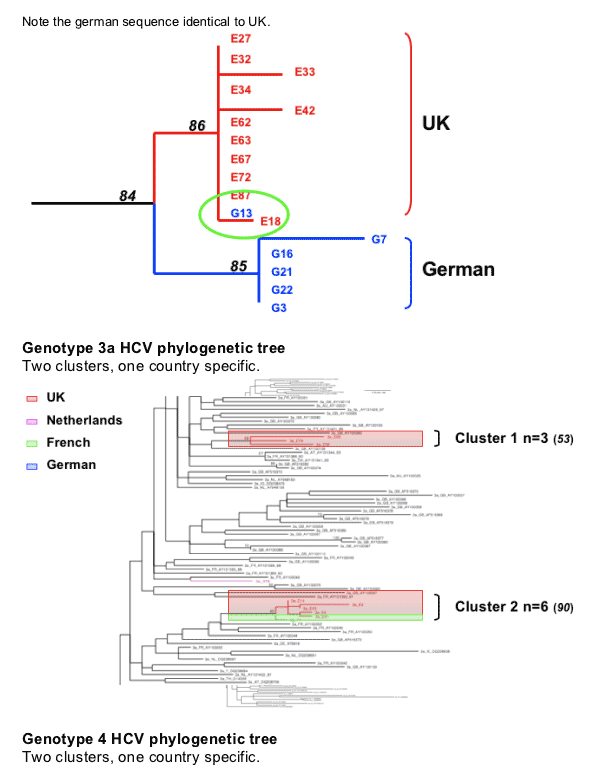
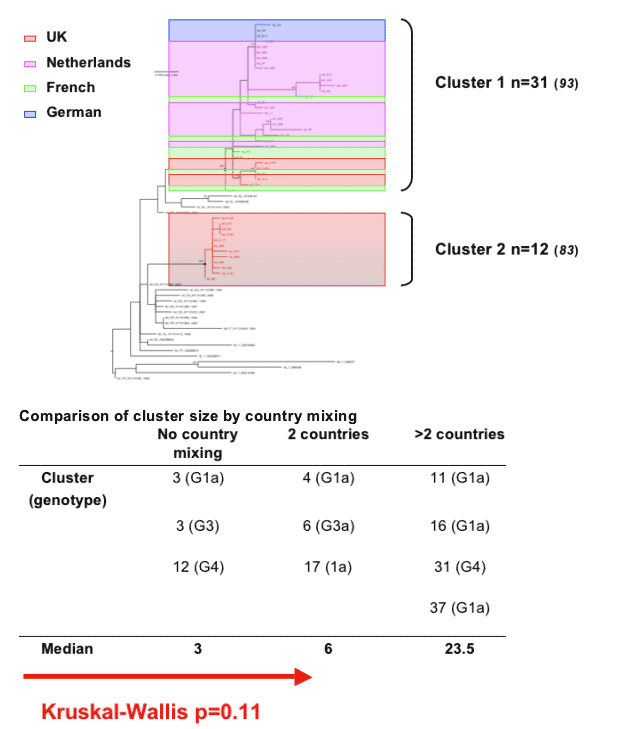
|
| |
|
 |
 |
|
|